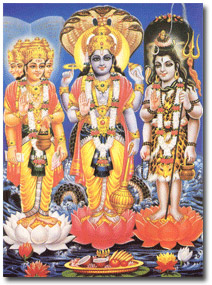 Brahma, Vishnu and Shiva of the Hindu Trinity parallel the western concept of the Father, Son and Holy Spirit—the eternal Creator, Preserver and Destroyer. Brahma embodies the divine desire that inspired the creation of the world. Vishnu conveys mercy and virtue to sustain the world. Shiva represents the sacred fire that destroys evil. Brahma, as the Father figure and the First Person of the Trinity, is seen as the Immense Being—the Creator, Supreme Ruler, Lawgiver, Sustainer and Source of All Knowledge. Brahma is Godly omnipotence incarnate. His divine complement, or shakti, is Sarasvati, the active principle of Brahma. These divine lovers exemplify the masculine and feminine embodiment of the cosmic force.
Brahma, Vishnu and Shiva of the Hindu Trinity parallel the western concept of the Father, Son and Holy Spirit—the eternal Creator, Preserver and Destroyer. Brahma embodies the divine desire that inspired the creation of the world. Vishnu conveys mercy and virtue to sustain the world. Shiva represents the sacred fire that destroys evil. Brahma, as the Father figure and the First Person of the Trinity, is seen as the Immense Being—the Creator, Supreme Ruler, Lawgiver, Sustainer and Source of All Knowledge. Brahma is Godly omnipotence incarnate. His divine complement, or shakti, is Sarasvati, the active principle of Brahma. These divine lovers exemplify the masculine and feminine embodiment of the cosmic force.
Words from the Masters - Brahma, Vishnu and Shiva »
Adapted from The Masters and Their Retreats
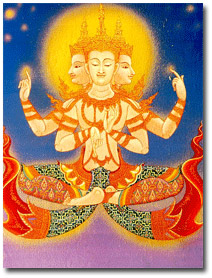 Brahma, as Father figure and the First Person of the Trinity, is seen as the Immense Being—the Creator, Supreme Ruler, Lawgiver, Sustainer and Source of All Knowledge. Brahma is the Godly omnipotence incarnate. His divine complement, or shakti, is Sarasvati, the active principle of Brahma. These divine lovers exemplify the masculine and feminine embodiment of the cosmic force. '
Brahma, as Father figure and the First Person of the Trinity, is seen as the Immense Being—the Creator, Supreme Ruler, Lawgiver, Sustainer and Source of All Knowledge. Brahma is the Godly omnipotence incarnate. His divine complement, or shakti, is Sarasvati, the active principle of Brahma. These divine lovers exemplify the masculine and feminine embodiment of the cosmic force. '
Words from the Masters - Brahma »
Adapted from The Masters and Their Retreats
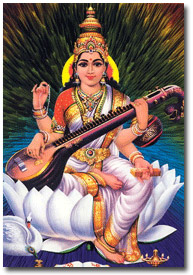 The Divine Mother in her manifestation as Sarasvati is the shakti [strength] of Brahma. Together, Brahma and Sarasvati are the embodiment of cosmic force. Sarasvati is known as the Goddess of the Word. She is identified with the Vac, the Word. She represents eloquence and articulates the wisdom of the Law. She is the Mother-Teacher to those of us who love the Law revealed by Brahma, and she is the power of volition, the will and motivation to be the Law in action. Sarasvati represents the union of power and intelligence from which organized creation arises.
The Divine Mother in her manifestation as Sarasvati is the shakti [strength] of Brahma. Together, Brahma and Sarasvati are the embodiment of cosmic force. Sarasvati is known as the Goddess of the Word. She is identified with the Vac, the Word. She represents eloquence and articulates the wisdom of the Law. She is the Mother-Teacher to those of us who love the Law revealed by Brahma, and she is the power of volition, the will and motivation to be the Law in action. Sarasvati represents the union of power and intelligence from which organized creation arises.
Sarasvati is associated with speech, poetry, music and culture and is known as the Goddess of Learning and the Patroness of the Arts and Music. She is revered by both Hindus and Buddhists. Sarasvati is sometimes represented with four hands, sitting on a lotus. She holds the sacred scriptures in one hand and a lotus in another. With the remaining two hands, she plays the Indian lute (veena). She is called the Flowing One, the source of creation by the Word. Sarasvati also represents purity and wears white. Her transcendent nature is suggested in her vehicle, the swan, which is a symbol of spiritual transcendence and perfection. Her sacred “seed syllable,” or bija, is Aim. Sarasvati’s mantra is Om Aim Sarasvatye Namha.
Words from the Masters - Sarasvati »
Adapted from The Masters and Their Retreats
 Krishna is a divine being, an incarnation of the Godhead, an avatar, and he is one of the most celebrated Indian heroes of all times. He has captured the imagination and devotion of Hindus everywhere in his many forms – whether as a frolicking, mischievous child, as the lover of shepherdesses, or as the friend and wise counselor of the mighty warrior Arjuna. Krishna is known as the eighth incarnation of Vishnu, the Second Person of the Hindu Triad. His story is told in the Bhagavad Gita, the most popular religious work of India, composed between the fifth and second centuries B.C. and part of the great epic, the Mahabharata.
Krishna is a divine being, an incarnation of the Godhead, an avatar, and he is one of the most celebrated Indian heroes of all times. He has captured the imagination and devotion of Hindus everywhere in his many forms – whether as a frolicking, mischievous child, as the lover of shepherdesses, or as the friend and wise counselor of the mighty warrior Arjuna. Krishna is known as the eighth incarnation of Vishnu, the Second Person of the Hindu Triad. His story is told in the Bhagavad Gita, the most popular religious work of India, composed between the fifth and second centuries B.C. and part of the great epic, the Mahabharata.
Words from the Masters - Krishna »
Adapted from The Masters and Their Retreats
 The Divine Mother in her manifestation as Lakshmi is the shakti [strength] of Vishnu. Lakshmi is known in earlier Eastern texts as Sri, which means “splendor,” “beauty,” “prosperity,” “wealth.” Vishnu holds the office of Preserver in the Hindu Trinity while Lakshmi shares his role as preserver. Her wisdom is revealed in blessings of prosperity and the precipitation of the abundant life. She embodies divine compassion and intercedes on our behalf before her consort. Lakshmi also teaches us mastery of karmic cycles on the comic clock. She is worshipped in every home on every important occasion. Lakshmi’s seed syllable, or bija, is Srim. Her mantra is Om Srim Lakshmye Namaha.
The Divine Mother in her manifestation as Lakshmi is the shakti [strength] of Vishnu. Lakshmi is known in earlier Eastern texts as Sri, which means “splendor,” “beauty,” “prosperity,” “wealth.” Vishnu holds the office of Preserver in the Hindu Trinity while Lakshmi shares his role as preserver. Her wisdom is revealed in blessings of prosperity and the precipitation of the abundant life. She embodies divine compassion and intercedes on our behalf before her consort. Lakshmi also teaches us mastery of karmic cycles on the comic clock. She is worshipped in every home on every important occasion. Lakshmi’s seed syllable, or bija, is Srim. Her mantra is Om Srim Lakshmye Namaha.
Words from the Masters - Lakshmi »
Adapted from The Masters and Their Retreats
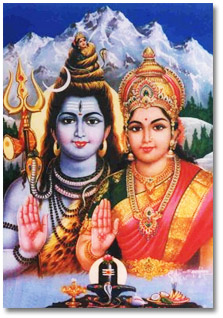 Shiva is one of the most popular deities in India. Along with Brahma and Vishnu, he is part of the Hindu triad, the trimurti. Shiva’s devotees revere him as the supreme Reality, the total Godhead. They also see him as the Guru of all gurus, the destroyer of worldliness, ignorance, evil and evildoers, hatred and disease. He bestows wisdom and long life, and he embodies renunciation and compassion. The relationship of Shiva with his devotees is an intensely personal one. Although he resides at Mount Kailash (in the Himalayan mountains), his favorite home is in the heart of his devotees.
Shiva is one of the most popular deities in India. Along with Brahma and Vishnu, he is part of the Hindu triad, the trimurti. Shiva’s devotees revere him as the supreme Reality, the total Godhead. They also see him as the Guru of all gurus, the destroyer of worldliness, ignorance, evil and evildoers, hatred and disease. He bestows wisdom and long life, and he embodies renunciation and compassion. The relationship of Shiva with his devotees is an intensely personal one. Although he resides at Mount Kailash (in the Himalayan mountains), his favorite home is in the heart of his devotees.
Parvati is the gentle mother and wife. Her union with Shiva is a prototype of the ideal marriage. A beautiful, gracious woman, she is often depicted with Shiva in domestic scenes or seated beside him in discourse. Hindus believe that Shiva and Parvati live on the summit of Mount Kailash. Some artistic representations of Shiva show him as half-man and half-woman. According to the legend, Shiva was determined that there be no separation between himself and his shakti, and he therefore decreed that his right side be Shiva and his left be Parvati.
Words from the Masters - Shiva and Parvati »
Adapted from The Masters and Their Retreats
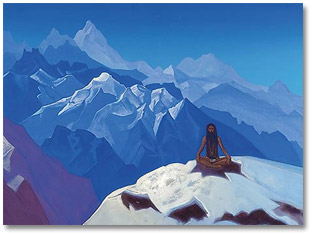 Vaivasvata Manu and his consort are the Manus of the fifth root race. As manus, they hold the archetypical pattern for that root race and sponsor the Christic path for all souls of that evolution. Vaivasvata is a Sanskrit word meaning “sun-born” – born of the Sun, born of the Great Central Sun. In Hindu teachings, Vaivasvata is a poet, sage and guru. He is also one of the manus, or divine lawgivers, who guide the lives of mankind. Hindus believe that he is the manu of the present age.
Vaivasvata Manu and his consort are the Manus of the fifth root race. As manus, they hold the archetypical pattern for that root race and sponsor the Christic path for all souls of that evolution. Vaivasvata is a Sanskrit word meaning “sun-born” – born of the Sun, born of the Great Central Sun. In Hindu teachings, Vaivasvata is a poet, sage and guru. He is also one of the manus, or divine lawgivers, who guide the lives of mankind. Hindus believe that he is the manu of the present age.
Words from the Masters - Vaivasvata Manu »Adapted from The Masters and Their Retreats
 Kali is the most fearsome of Shiva’s consorts. She is depicted as dark blue in color with fierce, blazing eyes. Kali is usually shown with a terrifying countenance, her tongue protruding, wearing a necklace of human skulls or heads and a belt of severed arms. In one hand, she holds a sword, in the others she may hold the severed head of a demon, a shield or a noose; her hands may also make the sign of fearlessness and offer blessings and benefits.
Kali is the most fearsome of Shiva’s consorts. She is depicted as dark blue in color with fierce, blazing eyes. Kali is usually shown with a terrifying countenance, her tongue protruding, wearing a necklace of human skulls or heads and a belt of severed arms. In one hand, she holds a sword, in the others she may hold the severed head of a demon, a shield or a noose; her hands may also make the sign of fearlessness and offer blessings and benefits.
Kali’s dread appearance symbolizes her boundless power. Her destruction is seen as ultimately leading to transformation and salvation. The object of her wrath is not the outer form of man but his inner delusions. She shatters the delusions of the ego and destroys ignorance, even as she brings blessings to those who seek to know God. She destroys the form and substance of human creations that are not aligned will the will of her consort, thus liberating those who seek the knowledge of God. Kali bestows blessings to her devotees and is revered by her aspirants as the Divine Mother. Kali’s bija mantra is Krim. Another mantra honoring Kali is Om Krim Kalikaye Namaha.
Words from the Masters - Goddess Kali »
Adapted from The Masters and Their Retreats
 Durga is one of Shiva’s consort or shakti [strength]. Shiva’s [the third person of the Hindu Trinity] other two consorts are Parvati and Kali. Durga is called the Goddess Beyond Reach, or the Unfathomable One. Terrible and menacing to her enemies, she rides on the back of a tiger, which represents the demon of the lower self. Hindus believe that Durga manifests herself again and again in order to protect the world and all God’s children. Durga’s seed syllable, or bija mantra, is Dum. Another mantra honoring Durga is Om Dum Durgaye Namaha.
Durga is one of Shiva’s consort or shakti [strength]. Shiva’s [the third person of the Hindu Trinity] other two consorts are Parvati and Kali. Durga is called the Goddess Beyond Reach, or the Unfathomable One. Terrible and menacing to her enemies, she rides on the back of a tiger, which represents the demon of the lower self. Hindus believe that Durga manifests herself again and again in order to protect the world and all God’s children. Durga’s seed syllable, or bija mantra, is Dum. Another mantra honoring Durga is Om Dum Durgaye Namaha.
Words from the Masters - Durga »
Adapted from The Masters and Their Retreats
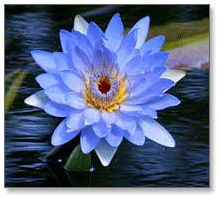 Himalaya is the manu of the fourth root race. He is also the hierarch of the Retreat of the Blue Lotus in the Himalayan Mountains, guardian of the ray of the masculine aspect of the Godhead focused directly from the heart of Alpha. The gentle radiance of
Himalaya can be felt throughout the East as a tangible presence drawing the pilgrims of all nations into a divine awareness of the
flame of the blue lotus.
Himalaya is the manu of the fourth root race. He is also the hierarch of the Retreat of the Blue Lotus in the Himalayan Mountains, guardian of the ray of the masculine aspect of the Godhead focused directly from the heart of Alpha. The gentle radiance of
Himalaya can be felt throughout the East as a tangible presence drawing the pilgrims of all nations into a divine awareness of the
flame of the blue lotus.
A root race is a group of souls, or a lifewave, who embody together and have a unique archetypical pattern, divine plan and mission to fulfill. The manus (Sanskrit for “progenitors” or “lawgivers”) ensoul the Christic image for the lifewave they sponsor. According to esoteric tradition, there are seven primary groups of souls, i.e., the first to seventh root races. Adapted from The Masters and Their Retreats
Words from the Masters - Lord Himalaya »
The Manu and his divine complement are twin flames assigned by the Father-Mother God to sponsor and ensoul the Christic image for a certain evolution or lifewave known as a root race—souls who embody as a group and have a unique archetypal pattern, divine plan and mission to fulfill on earth.
From The Masters and Their Retreats
For further information about the Manus, see Book 4 of the
Climb the Highest Mountain series, The Path of Brotherhood.
